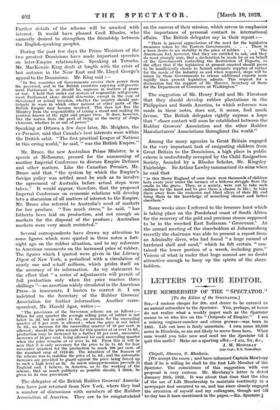Several correspondents have drawn my attention to some figures which
were quoted in these notes a fort- night ago on the rubber situation, and to my reference to American comments on the increased price of rubber. The figures which I quoted were given in the Literary Digest of New York, a periodical with a circulation of nearly one and a-half millions, which prides itself on the accuracy of its information. As my statement to the effect that "a series of adjustments will permit of full production only when the price reaches three shillings "—an assertion widely circulated in the American Press—is inaccurate, I hasten to correct it. I am indebted to the Secretary of the Rubber Growers' Association for further information. Another corre- spondent, Mr. Harold Agar, writes :— " The provisions of the Stevenson scheme are as follows :- When for any quarter the average selling price of rubber is not below is. 8d. but is under is. 6d., an increase fur the succeeding quarter of 5 per cent. is allowed ; when the price is not below 1s. 6d., an increase for the succeeding quarter of 10 per cent, is allowed ; should the price remain for this quarter at or over is. 6d., production may be increased by a further 10 per cent., successive increases of 10 per cent. being allowed for each succeeding quarter when the price remains at or over Is. 6d. From this it will be seen that it is only necessary for the price to be Is. 6d. for four successive quarters for the production to reach 100 per cent, of the standard crop of 1919-20. The intention of the framers of the scheme was to stabilize the price at Is. Cid., and the automatic increases are provided to guard against the price being forced up to such a high level as Be. So much misapprehension prevails in England and, I believe, in America, as to the working of the scheme, that as much publicity as possible should, I think, be given to its true provisions."










































 Previous page
Previous page